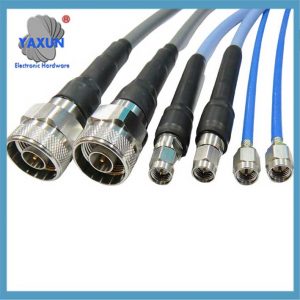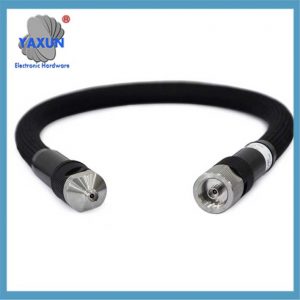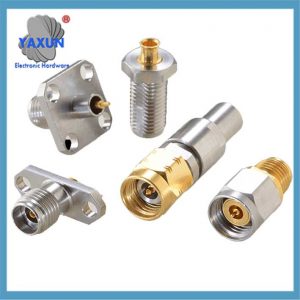Microwave and millimeter wave coaxial connectors with cables are crucial components in the field of high-frequency communications. They are responsible for transmitting microwave and millimeter wave signals between devices. The following is a detailed introduction to this type of connector:
 China Low Loss RF Cable Assemblies-SMA, Type N and TNC Conditioned Cable Assembly |
 China RF Cables and RF Cable Assemblies Microwave Millimeter Wave mm wave High Frequency Radio Connector Cables |
 Microwave & RF Connector Products – 2.92mm Connector and Cable Assembly -The High Frequency Applications for Microwave Field |
1. Definition and Use
Microwave and millimeter wave coaxial connectors with cables are mainly used to connect microwave and millimeter wave transmission lines to achieve stable transmission of high-frequency signals. They are widely used in wireless communications, radar, satellite communications, test and measurement and other fields that require processing of high-frequency signals.
2. Structure and Features
Structure: This type of connector is usually composed of a center conductor, an insulator, an outer conductor (shielding layer), a connector, and a cable. The choice of cable is usually based on factors such as the frequency, attenuation characteristics, and impedance matching of the transmitted signal.
Features:
High-frequency transmission performance: It can support the stable transmission of microwave and millimeter wave signals, and has excellent performance such as low loss and high standing wave ratio.
Strong anti-interference ability: A good shielding layer design can effectively prevent signal interference and noise interference, ensuring the reliability and clarity of signal transmission.
Flexibility and durability: The cable part is usually highly flexible, which is convenient for wiring in complex environments; at the same time, the connector part is made of high-quality materials and has high durability.
3. Types and specifications
Microwave and millimeter wave coaxial connectors with cables are of various types, including SMA, SMB, BNC and other types, as well as specifications of different sizes, frequency ranges and impedance matching. Choosing the right type and specification depends on factors such as application requirements, working environment, and the frequency and power of the transmitted signal.
4. Application Cases
Wireless communication: used to connect base stations, relay stations, mobile terminals and other equipment to achieve the transmission and reception of microwave and millimeter wave signals.
Radar system: used to connect radar transmitters, receivers, antennas and other equipment to achieve the transmission, reception and processing of radar signals.
Satellite communication: used to connect satellite ground stations, terminal equipment, etc.. to achieve long-distance transmission of microwave and millimeter wave signals.
Test and measurement: used to connect test instruments, equipment under test, etc.. to measure and analyze high-frequency signals.
5. Precautions for selection and use
Choose the appropriate type and specification: Choose the appropriate type and specification of microwave and millimeter wave coaxial connectors with cables according to application requirements and working environment.
Pay attention to installation and maintenance: During installation, ensure the correct docking and fixation of the connectors; during maintenance, regularly check the performance and status of the connectors, and replace damaged or aging connectors in time.
Prevent signal interference and loss: During use, pay attention to prevent signal interference and loss to ensure the stability and clarity of signal transmission. At the same time, avoid excessive bending or stretching of the cable to avoid adverse effects on transmission performance.
In summary, microwave and millimeter wave coaxial connectors with cables play an important role in the field of high-frequency communications. Understanding and mastering the relevant knowledge will help to better apply and maintain these components, ensure the normal operation of the communication system and the quality of signal transmission.
In the RF and microwave industry, there are many types of coaxial connectors designed for specific uses and applications that are smaller and operate at frequencies up to the GHz and mmWave range. A connector standard generally accepted in the industry, this type of connector is compatible with other RF/microwave components, so it can be used for interconnection with coaxial modules in the system, maintaining the coaxial characteristics of the corresponding transmission lines. As with coaxial cables, impedance, frequency range, power handling capabilities, physical size, and cost are also factors to consider when determining the best connector type for a specific application.
In RF and microwave applications, connectors are usually divided into the following three grades: production grade, instrument grade and metrology grade. Production grade connectors are low cost, simple construction and can be used to mate with components and cables in most common applications. Instrumentation grade connectors are precision or test connectors that meet the high performance standards of low reflection and high repeatability used in test and measurement equipment. Metrology-grade connectors are high-precision, high-accuracy connectors, but are usually more expensive. Today, high-band microwave and mmWave coaxial cables and connectors are increasingly being used in prototyping and production in the military and aerospace sectors. These products are designed to meet the high reliability (Hi-rel) standards required in these fields.
Generally, there are three characteristics that identify a connector: the type of connector; the coaxial cable connected to the connector; and the male-female design of the connector after mating. Depending on the design features, the number of reliable mating cycles for a paired connector is typically 50 to hundreds of times. Two connectors that are mated can share the same specifications, while design features such as silver-clad nickel plating can lead to significant performance improvements.
Connector Types and Frequency Limits
RF/Microwave coaxial connectors fall into several categories. As with coaxial cables, the cutoff frequency is a critical characteristic for any coaxial cable connector, representing the highest frequency at which the desired single TEM propagation mode can be maintained. The frequency range of any connector is limited by the propagation modes in the corresponding coaxial system. Millimeter wave coaxial connectors refer to coaxial connectors for frequencies above 18 GHz.
Type N, BNC and TNC connectors
Le 50 Ohm Type-N connector was developed in the 1940s for military systems operating below 5 GHz. Type N connectors feature an inner gasket with an air gap between the center conductor and outer conductor. Subsequent improvements have increased their performance up to 18 GHz, but even the latest designs start to experience propagation mode changes around 20 GHz. That said, unpredictable results will occur when using this type of connector at 20 GHz or higher. 75 ohm Type N connectors are widely used in the cable TV industry. BNC connectors for video and RF applications up to 2 GHz feature slotted outer conductors and a plastic dielectric for both male and female connectors. At high frequencies above 4 GHz, the slot can emit signals up to about 10 GHz. Because the mating geometry of BNC connectors is compatible with N-connectors, certain BNC connectors can temporarily mate with N-type connectors of the corresponding polarity. The TNC connector is a threaded version of the BNC connector, this version helps with leakage and stability issues and allows use at frequencies up to 12 GHz and 18 GHz. TNC connectors are widely used for RF/antenna connections in cellular phones.
SMA and SMB push-on connectors
The SMA (subminiature A type) connector uses a 4.2 mm diameter outer coaxial conductor and is filled with PTFE dielectric. Depending on the manufacturer, the upper limit frequency is 18~26 GHz. The SMA connector is sized to fit a 5/16″ (12.7/40.6cm) wrench and mates with 3.5mm and 2.92mm connectors. The SMB (subminiature B) connector is a push-on connector, usually used for frequencies from 4 GHz to 12.4 GHz. As people require higher and higher frequencies, this type of connector has the problem of being too bulky and unable to provide the bandwidth required for high-frequency applications.
3.5mm and 2.92mm connectors
These two connectors with air media are not only compatible with each other, but also with SMA connectors. The 3.5mm connector works stably at frequencies up to 26 GHz, while the 2.92mm connector works up to 40 GHz.
2.4mm and 1.85mm connectors
2.4mm and 1.85mm connectors are compatible with each other, but their design is not compatible with SMA, 3.5mm and 2.92mm connectors. This is because these two types of connectors are more precise and more expensive, and mating with lower precision connectors may cause irreparable damage.
1mm and 0.8mm connectors
Suitable for mmWave analysis, these two connectors support transmission and repeatable interconnection applications in the DC~110 GHz range.
 English
English العربية
العربية Български
Български Čeština
Čeština Dansk
Dansk Nederlands
Nederlands Suomi
Suomi Français
Français Deutsch
Deutsch Magyar
Magyar Italiano
Italiano 日本語
日本語 한국어
한국어 Português
Português Română
Română Русский
Русский Slovenščina
Slovenščina Español
Español Svenska
Svenska Tiếng Việt
Tiếng Việt
